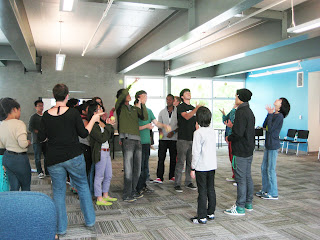After the introductory activity, Dr. Jeff Silverman from UC Berkeley gave a short lecture on supernovae. It was awesome! Definitely one of the best lectures I've heard on the subject; very engaging and great for the audience level. A theme throughout the summer has been "why can't scientists effectively communicate their science?" -- hearing a scientist so effectively talk about supernovae and his research to a high school class was pretty enlightening.
Then we were on to the fun stuff! Vivian (also from the ASP) and I went through a couple of activities. First, she brought along a large poster that went through the life cycle of stars, but sun-like and massive. It was great seeing such an effective educator in her element. Then we went on to do a kinesthetic life cycle of stars activity, where the kids mimic the core and outer envelope of stars and the gravitational and fusion pressures within the star, through balancing activities. We go through each phase of the star from star-forming regions to protostar and so on and then to the death of star in both sun-like and massive stars.
We then went into an activity that mimics core collapse within massive stars using tennis and ping pong balls. We ended with an activity that goes through all the elements that supernovae provide us! At the end of the session, the students realize that we would only have stars and gas-planets --no diamond rings, no computers, and no humans!
We left before the art portion, but they did a lot of cool splatter paint activities that embodied a lot of supernovae-like traits.
Here are some photos from the event:
^^ the students acting out a supernova explosion! Note my excitement on the side :)
^^ an activity that used tennis and ping pong balls to mimic why more massive and less massive particles react different during a supernova. In a SN, the core is going to contract and become EXTREMELY dense. The core and the outer layers of the star are going to fall inwards; once the neutrons (formed from the intense packing of protons and electrons at the center of the star) are packed as tightly as they can, the core collapse stops and the material falling inward will "bounce" outwards. the different layers of a stars during a SN in different ways depending on their mass. By bouncing a ping pong ball on top of a tennis ball onto the ground, you can see that the tennis ball is going to bounce less (b/c gravity is pulling on it more), while the ping pong ball is going to shoot up, in a similar fashion to less massive particles. This is a simplified model, but shows how gravity is important in a SN and how different particles are going to react differently throughout this stellar process.
^^ what do SN give us activity? I'll ruin the punch line: US! We wouldn't be alive without supernovae! The iron in our blood, the calcium in our bones -- all thanks to the deaths of super massive stars!



No comments:
Post a Comment